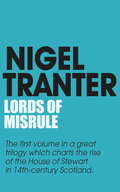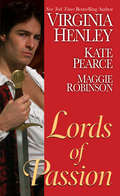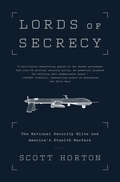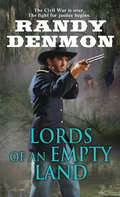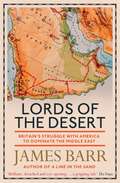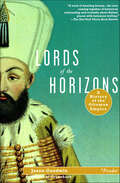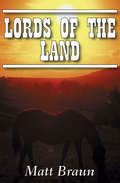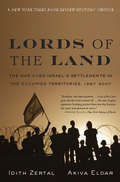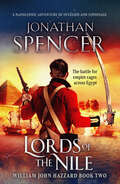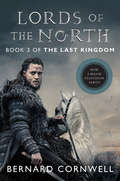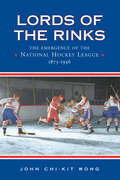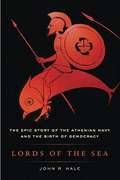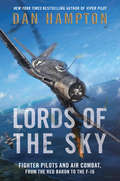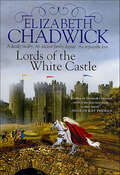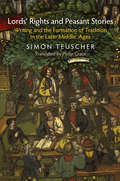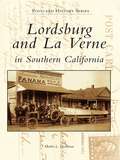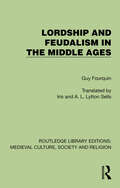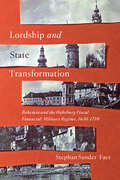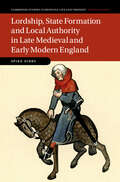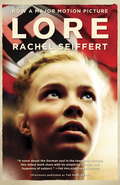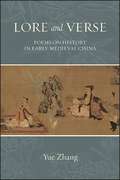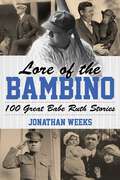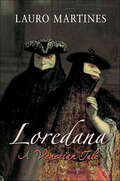- Table View
- List View
Lords of Misrule: House of Stewart Trilogy 1
by Nigel TranterIn turbulent 14th century Scotland, the ruling House of Stewart was a house divided, beset by hatred and jealousy. Descendants of the Bruce's daughter, they only kept the throne by an astonishing genius for survival - or, as many said, the lick of the Devil. Their rivals were the Douglases; and when the second Earl was slain in battle, the Stewarts were suspected of foul play. When young Jamie Douglas vowed to avenge his master, he only had his wits, courage and integrity with which to challenge the most eminent and the most unscrupulous men in the kingdom. And while vengeance burned in his heart, he could not prevent his fatal attraction for the beautiful and spirited Stewart women - and one in particular. This is the first volume in the Stewart trilogy. 'Through his imaginative dialogue, he provides a voice for Scotland's heroes' Scotland on Sunday
Lords of Passion
by Virginia Henley Kate PearceReaders will float away on the literary flair of these escapist tales, each touched with just the right amount of eroticism.--Publishers Weekly"Beauty and the Brute" by Virginia HenleyIt's been three years since Lady Sarah Caversham set eyes on arrogant Charles Lennox--the husband her father chose for her to settle a gambling debt. Now Charles has returned, unaware that the innocent ingénue he wed is determined to turn their marriage of convenience into a passionate affair. . . "How to Seduce a Wife" by Kate PearceLouisa March's new husband, Nicholas, is a perfect gentleman in bed--much to her disappointment. She longs for the kind of fevered passion found in romance novels. But when she dares him to seduce her properly, she discovers Nicholas is more than ready to meet her challenge... "Not Quite a Courtesan" by Maggie RobinsonSensible bluestocking Prudence Thorn has been too busy keeping her cousin Sophy out of trouble to experience any adventures of her own. But when Sophy begs Prudence's help in saving her marriage, Pru encounters handsome, worldly Darius Shaw. Under Darius's skilled tutelage, Pru learns just how delightful a little scandal can be. . ."These three talented authors show the many sides of desire. . . enough to please any reader seeking pleasure."--Romantic Times, 4 Stars"Readers will delight as fantasies are played out and passion is given free rein." --Romantic Times, 4 Stars
Lords of Secrecy: The National Security Elite and America's Stealth Warfare
by Scott HortonForty years ago, a majority of Americans were highly engaged in issues of war and peace. Whether to go to war or keep out of conflicts was a vital question at the heart of the country's vibrant, if fractious, democracy. But American political consciousness has drifted. In the last decade, America has gone to war in Iraq and Afghanistan, while pursuing a new kind of warfare in Yemen, Somalia, Libya, and Pakistan. National security issues have increasingly faded from the political agenda, due in part to the growth of government secrecy.<P> In lucid and chilling detail, journalist and lawyer Scott Horton shows how secrecy has changed the way America functions. Executive decisions about war and peace are increasingly made by autonomous, self-directing, and unaccountable national security elites. Secrecy is justified as part of a bargain under which the state promises to keep the people safe from its enemies, but in fact allows excesses, mistakes, and crimes to go unchecked. Bureaucracies use secrets to conceal their mistakes and advance their power in government, invariable at the expense of the rights of the people. Never before have the American people had so little information concerning the wars waged in their name, nor has Congress exercised so little oversight over the war effort. American democracy is in deep trouble.<P> Lords of Secrecy explores the most important national security debates of our time, including the legal and moral issues surrounding the turn to private security contractors, the sweeping surveillance methods of intelligence agencies, and the use of robotic weapons such as drones. Horton looks at the legal edifice upon which these decisions are based and discusses approaches to rolling back the flood of secrets that is engulfing America today.Whistleblowers, but also Congress, the public, and the media, play a vital role in this process.<P> As the ancient Greeks recognized, too much secrecy changes the nature of the state itself, transforming a democracy into something else. Horton reminds us that dealing with the country's national security concerns is both a right and a responsibility of a free citizenry, something that has always sat at the heart of any democracy that earns the name.
Lords of an Empty Land
by Randy DenmonIn the days of reconstruction after the Civil War, a wild strip of land in northern Louisiana remained unconquered by troops and untamed by the law. This is the story of the fearless veterans--Union and Confederate--who dared to enter this beautiful but hellish valley. . .and finish what the war started.Lords Of An Empty LandRed River Valley, 1869. Hoardes of ex-Confederate soldiers have emerged from the piney hills and mosquito infested swamps of Lousiana backcountry in a final, bloody show of defiance. After a series of violent raids on carpetbaggers, freed slaves, and northern cargo ships, Captain Douglas Owens of the 4th Calvary is given orders to reclaim this God-forsaken land from its murderous outlaw gangs. By Owens' side is Huff, a former slave, and Basil Dubose, an ex-Rebel gunslinger for hire who answers to no man but his paymaster. With each deadly encounter, it becomes clear to Owens that neither the Army nor the public is willing to spill blood for the sake of freed slaves. With his options dwindling, the Captain takes a squad of soldiers under his command--in a last desperate bid for freedom and justice that would change the course of history. . .
Lords of the Desert: Britain's Struggle with America to Dominate the Middle East
by James Barr'Compelling... This is essential, gripping history with major relevance for those who wish to understand that tortured region today.'—Nicholas Burns, Professor, Harvard University and former Under Secretary of State 'High adventure and covert action meet in this account of a momentous power shift that decisively shaped today’s world.'—Stephen Kinzer, author of All the Shah’s Men and Overthrow 'An essential book for understanding the modern Middle East—and a thrilling read to boot.'—Alex von Tunzelmann, author of Blood and Sand Upon victory in 1945, Britain still dominated the Middle East. She directly ruled Palestine and Aden, was the kingmaker in Iran, the power behind the thrones of Egypt, Iraq and Jordan, and protected the sultan of Oman and the Gulf sheikhs. But her motives for wanting to dominate this crossroads between Europe, Asia and Africa were changing. Where ‘imperial security’ – control of the route to India – had once been paramount, now oil was an increasingly important factor. So, too, was prestige. Ironically, the very end of empire made control of the Middle East precious in itself: on it hung Britain’s claim to be a great power.Unable to withstand Arab and Jewish nationalism, within a generation the British were gone. But that is not the full story. What ultimately sped Britain on her way was the uncompromising attitude of the United States, which was determined to displace the British in the Middle East.The British did not give in gracefully to this onslaught. Using newly declassified records and long-forgotten memoirs, including the diaries of a key British spy, James Barr tears up the conventional interpretation of this era in the Middle East, vividly portraying the tensions between London and Washington, and shedding an uncompromising light on the murkier activities of a generation of American and British diehards in the region, from the battle of El Alamein in 1942 to Britain’s abandonment of Aden in 1967. Reminding us that the Middle East has always served as the arena for great power conflict, this is the tale of an internecine struggle in which Britain would discover that her most formidable rival was the ally she had assumed would be her closest friend.Reviews for A Line In The Sand:- 'Masterful' —The Spectator 'With superb research and telling quotations, Barr has skewered the whole shabby story' —The Times 'Lively and entertaining. He has scoured the diplomatic archives of the two powers and has come up with a rich haul that brings his narrative to life' —Financial Times
Lords of the Desert: The Battle Between the United States and Great Britain for Supremacy in the Modern Middle East
by James BarrA path-breaking history of how the United States superseded Great Britain as the preeminent power in the Middle East, with urgent lessons for the present dayWe usually assume that Arab nationalism brought about the end of the British Empire in the Middle East--that Gamal Abdel Nasser and other Arab leaders led popular uprisings against colonial rule that forced the overstretched British from the region. In Lords of the Desert, historian James Barr draws on newly declassified archives to argue instead that the US was the driving force behind the British exit. Though the two nations were allies, they found themselves at odds over just about every question, from who owned Saudi Arabia's oil to who should control the Suez Canal. Encouraging and exploiting widespread opposition to the British, the US intrigued its way to power--ultimately becoming as resented as the British had been. As Barr shows, it is impossible to understand the region today without first grappling with this little-known prehistory.
Lords of the Horizons: A History of the Ottoman Empire
by Jason Goodwin“An elegantly written, thoroughly entertaining work of popular history” examining the Ottoman Empire and its legacy (Kirkus Reviews).For six hundred years, the Ottoman Empire swelled and declined. Islamic, martial, civilized, and tolerant, it advanced in three centuries from the dusty foothills of Anatolia to rule on the Danube and the Nile. At its height, Indian rajahs and the kings of France beseeched the empire’s aid. In its last three hundred years the empire seemed ready to collapse, a prodigy of survival and decay. In this striking evocation of the empire’s power, Jason Goodwin explores how the Ottomans rose and how, against all odds, they lingered on. In doing so, he also offers a long look back at the origins of problems that plague present-day Kosovars and Serbs.Praise for Lords of the Horizons“Jason Goodwin’s deftly written and beguiling history of the Ottoman Empire is particularly pertinent today, when the cauldron of ancient hatred once more boils over, but his prose would be welcome at any time.” —The Boston Globe“A work of dazzling beauty . . . the rare coming together of historical scholarship and curiosity about distant places with luminous writing.” —The New York Times Book Review
Lords of the Land
by Matt BraunHank Laird had never laid claim to sainthood. Truth is, his enemies would be quick to swear that the man was the devil himself-a reputation Laird earned as one of the most hardscrabble men ever to grace the soil of South Texas. With grit, gold and gunpowder, he forged an empire out of chaos in the wake of the Civil War. But now the vultures are coming home to roost and it's up to Laird whether Santa Guerra ranchlands will be heaven or hell.
Lords of the Land: The War over Israel's Settlements in the Occupied Territories, 1967-2007
by Akiva Eldar Idith Zertal Vivian EdenLords of the Land tells the tragic story of Jewish settlement in the West Bank and Gaza Strip. In the aftermath of the 1967 war and Israel's devastating victory over its Arab neighbors, catastrophe struck both the soul and psyche of the state of Israel. Based on years of research, and written by one of Israel's leading historians and journalists, this involving narrative focuses on the settlers themselves - often fueled by messianic zeal but also inspired by the original Zionist settlers - and shows the role the state of Israel has played in nurturing them through massive economic aid and legal sanctions. The occupation, the authors argue, has transformed the very foundations of Israel's society, economy, army, history, language, moral profile, and international standing. "The vast majority of the 6. 5 million Israelis who live in their country do not know any other reality," the authors write. "The vast majority of the 3. 5 million Palestinians who live in the regions of their occupied land do not know any other reality. The prolonged military occupation and the Jewish settlements that are perpetuating it have toppled Israeli governments and have brought Israel's democracy and its political culture to the brink of an abyss. "
Lords of the Nile: An epic Napoleonic adventure of invasion and espionage (William John Hazzard series)
by Jonathan SpencerThe battle for Empire rages across EgyptThe thrilling second novel in the William John Hazzard series, following Napoleon's Run.Malta, June 1798. Captured by the French after hurling himself into enemy ranks, Hazzard is now a prisoner of his arch-nemesis, spycatcher Citizen Derrien, but has uncovered the true purpose of Napoleon’s armada: the conquest of Egypt. Their bold plan is to cut open the ancient Suez Canal to the Red Sea and attack India, the jewel in England’s crown. The survival of nations in the balance, Nelson scours the Mediterranean for the French in vain. If Hazzard can’t convince Admiralty Intelligence of a desperate plan, an ancient world will be lost for ever. But help comes from an unexpected quarter: the missing Admiralty agent…As French cannons roar in the desert sands and the Mamluk cavalry sweeps in to attack, Hazzard fights to prevent a lost cause turning into tragedy.From the shores of Malta to the epic encounter at the Battle of the Nile – this is the explosive beginning of the French conquest of Egypt. Never give up the boat.Praise for Jonathan Spencer‘Stupendous... Lords of the Nile has such a breathtakingly frenetic plot that I found myself getting faster and faster in my reading, tearing through the pages, only to realise that I was trying to match the pace of the characters and the plot. It is so immersive you can’t help but be sucked into it, swept away by it, pushed to tears by it and utterly enthralled by it.‘Jonathan Spencer is now one of my “Must read” authors, a drop-what-you’re-doing-(or whatever else you are reading)-and-read-it-now writer. My favourite book this year.’ Parmenion Books on Lords of the Nile‘This is an outstanding novel, made even more remarkable by its début status. Better than Sharpe, gripping and intense, Napoleon’s Run deserves to be a runaway success’ Ben Kane, Sunday Times bestselling author of Lionheart on Napoleon's Run'Hornblower meets Mission: Impossible. A thrilling, page-turning debut packed with rousing, rip-roaring action' J. D. Davies, author of the Matthew Quinton Journals on Napoleon's Run
Lords of the North: A Novel (Last Kingdom (formerly Saxon Tales) #3)
by Bernard CornwellThe third installment of Bernard Cornwell’s New York Times bestselling series chronicling the epic saga of the making of England, “like Game of Thrones, but real” (The Observer, London)—the basis for The Last Kingdom, the hit television series.The year is 878. Uhtred, the dispossessed son of a Northumbrian lord, has helped the Saxons of Wessex defeat the invading Danes. Now, finally free of his allegiance to the victorious, ungrateful King Alfred, he is heading home to rescue his stepsister, a prisoner of Kjartan the Cruel in the formidable Danish stronghold of Dunholm. Uhtred’s best hope is his sword, Serpent-Breath, for his only allies are Hild, a West Saxon nun fleeing her calling, and Guthred, a slave who believes himself king. Rebellion, chaos, fear, and betrayal await them in the north, forcing Uhtred to turn once more, reluctantly, to the liege he formerly served in battle and blood: Alfred the Great.
Lords of the Rinks
by John Chi-Kit WongNo sport is as important to Canadians as hockey. Though there may be a great many things that divide the country, the love of hockey is perhaps its single greatest unifier. Before the latest labour unrest in the National Hockey League (NHL), however, it was easy to forget that hockey is also a multi-million dollar business run, not by the athletes or coaches, but by corporate boards and businessmen. The Lords of the Rinks documents the early years of hockey?s professionalization and commercialization and the emergence of a fledgling NHL, from 1875 to 1936.As the popularity of hockey grew in Canada in the late nineteenth century, so too did its commercial aspects, and players, club directors, rink owners, fans, and media had developed deep emotional, economic, and ideological interests in the sport. Disagreement came in the ways and means of how organized hockey, especially at the elite level, should be managed. Hence, some coordination, by way of governing bodies, was required to maintain a semblance of order. These early administrative bodies tried to maintain a structure that would help to coordinate the various interests, set up standards of behaviour, and impose mechanisms to detect and punish violators of governance. In 1917, the NHL held its first games and by 1936 had become the dominant governing body in professional hockey.Having performed extensive research in the NHL archives ? including league meeting minutes, letters, memos, telegrams, as well as gate receipt reports ? John Chi-Kit Wong traces the commercial roots of hockey and argues that, in its organized form, the sport was rarely if ever without some commercial aspects despite labels such as amateur and professional. The Lords of the Rinks is the only truly comprehensive and scholarly history of the league and the business of hockey. Disclaimer: The image on page 22 has been removed at the request of the rights holder.
Lords of the Sea
by John R. HaleThe epic true story of Themistocles and the Battle of Salamis, and a rousing history of the world's first dominant navy and the towering empire it built The Athenian Navy was one of the finest fighting forces in the history of the world. It engineered a civilization, empowered the world's first democracy, and led a band of ordinary citizens on a voyage of discovery that altered the course of history. With Lords of the Sea, renowned archaeologist John R. Hale presents, for the first time, the definitive history of the epic battles, the fearsome ships, and the men-from extraordinary leaders to seductive rogues-that established Athens's supremacy. With a scholar's insight and a storyteller's flair, Hale takes us on an unforgettable voyage with these heroes, their turbulent careers, and far-flung expeditions, bringing back to light a forgotten maritime empire and its majestic legacy.
Lords of the Sky: Fighter Pilots and Air Combat, from the Red Baron to the F-16
by Dan HamptonBy the USAF F-16 legend behind the bestselling memoir Viper Pilot, this is the first comprehensive history of fighter pilots and air combat--a unique, riveting look at the aces of the sky, their machines, their most daring missions, and the epic conflicts they shaped, from the trailblazing aviators of World War I to today's supersonic jetsLords of the Sky is a thrilling history of the fighter pilot, masterfully written by one of the most decorated aviators in American history. A twenty-year USAF veteran who flew more than 150 combat missions and received four Distinguished Flying Crosses, Lt. Colonel Dan Hampton draws on his singular firsthand knowledge, as well as groundbreaking research in aviation archives and rare personal interviews with little-known heroes, including veterans of World War II, Korea, and Vietnam. In a seamless, sweeping narrative, Lords of the Sky tells the extraordinary stories behind the most famous fighter planes and the brave and daring heroes who made them legend. In the Great War, aces such as Manfred von Richthofen ("The Red Baron"), Eddie Rickenbacker, and Roland Garros faced horrific survival rates and became romantic heroes. The Second World War saw the RAF locked in a struggle for the fate of civilization during the Battle of Britain; on the Eastern Front, the German Luftwaffe and Soviet Air Force grappled in some of the fiercest and bloodiest air battles in history. In the Pacific, Japanese pilots terrorized Asia, culminating in their attack on Pearl Harbor. American flyboys quickly became instrumental to the Allies' ultimate victory, ravaging the enemy's navy, providing life-saving air support for ground troops, escorting bombers, and dogfighting with Japanese Zeros and Nazi Messerschmitts. During the Cold War, conflicts in Korea and Vietnam featured the dawn of the jet age, in which American pilots battled Soviet-made MiGs and increasingly sophisticated anti-aircraft weaponry. Hampton then draws on his own experience as an F-16 pilot who fought in the 1991 and 2003 wars against Iraq to bring to life the dangers and demands of today's modern fighter pilot.Here are the stories behind history's most iconic aircraft and the aviators who piloted them: from the Sopwith Camel and Fokker Triplane to the Mitsubishi Zero, Supermarine Spitfire, Nazi Bf 109, P-51 Mustang, Grumman Hellcat, F-4 Phantom, F-105 Thunderchief, F-16 Falcon, F/A-18 SuperHornet, and beyond. Here, too, are the Lafayette Escadrille, Flying Tigers, RAF Eagles, Wild Weasels, and other legendary units. Throughout this definitive history, Hampton clarifies the astonishing debt we owe to these daring Lords of the Sky who have ruled the air for more than a century.
Lords of the White Castle
by Elizabeth ChadwickWestminster, 1184-- in the court of King Henry, playful competition is about to turn into something far more serious. Young courtier Fulke FitzWarin would not be an obvious companion for Prince John, but the boy from the Welsh Marches is there as a reward for his family's loyalty to the crown. The FitzWarins are as proud as they are true, and when Fulke is accused by John of cheating during a game of chess, he cannot help but respond. Thus begins a bitter rivalry that will resonate throughout their lives.The FitzWarins dream of reclaiming their family estate and title, Lords of the White Castle. After this quarrel with Fulke, however, John's vindictiveness leads to Fulke renouncing his allegiance and becoming a rebel outlaw.In romance, too, Fulke is no closer to fulfilling his heart's desire. A youthful dalliance means nothing compared to his love for the spirited Maude le Vavasour, but marriage in medieval England is more about alliance than about love, and Fulke can only watch helplessly as Maude's father arranges a more suitable match. After all, what can Fulke offer Maude apart from a lifetime on the run....With all the intrigue and pageantry that bring the twelfth century vividly to life, this award-winning novelist spins us an irresistible tale of a deadly rivalry and an impossible love.
Lords' Rights and Peasant Stories: Writing and the Formation of Tradition in the Later Middle Ages (The Middle Ages Series)
by Simon TeuscherIn the mid-nineteenth century, Jacob Grimm published a collection of late medieval records of local law—called Weistümer—that was scarcely less comprehensive than his famous collection of fairy tales. As with the fairy tales, Grimm assumed that before their transcription, people had handed these down orally from time immemorial. His interest in these customary laws arose from their seemingly folkloristic notions of custom and from their poetic narratives about ritualized encounters between lords and peasants, capturing an oral tradition from an unsophisticated time.Grimm's readings are still used today as a basis for theories about oral societies in the premodern West and contemporary non-Western societies and the modernizing effects of writing. As Simon Teuscher contends, however, those aspects of legal texts that have been considered since Grimm to be vestiges of a traditional preliterate popular culture were eventually rooted in relatively advanced and learned techniques of writing, jurisprudence, and administration. Lords' Rights and Peasant Stories uses examples from German- and French-speaking Switzerland to investigate what legal order meant to individuals and to a society at the eve of the early modern period. Teuscher deals with legal documents not only as texts, but also as objects. The book takes the materiality of documents seriously and reconstructs cultural techniques of their production and social practices of their use.Lords' Rights and Peasant Stories suggests the need to rethink master narratives about transitions from oral to literate societies. It explores the local dimensions of processes of state-formation and the emergence of modern notions of law in western Europe. Students of rural society and village organization will find here a discussion of local power distribution that is inspired by social anthropology, that looks beyond simple antagonisms between lords and peasants, and that insists on the role of state servants and the unconscious effects of their writing practices.
Lordsburg and La Verne in Southern California (Postcard History)
by Marlin L. HeckmanFrom the 1890s through the 1920s, the postcard was an extraordinarily popular means of communication, and many of the postcards produced during this "golden age" can today be considered works of art. Postcard photographers traveled the length and breadth of the nation snapping photographs of busy street scenes, documenting local landmarks, and assembling crowds of local children only too happy to pose for a picture. These images, printed as postcards and sold in general stores across the country, survive as telling reminders of an important era in America's history. This fascinating history of Lordsburg and La Verne, California,showcases more than 200 of the best vintage postcards available.
Lordship and Feudalism in the Middle Ages (Routledge Library Editions: Medieval Culture, Society, & Religion)
by Guy FourquinOriginally published in English in 1976, this book shed new light upon a dark aspect of a dark age in the social history of Europe. The book discusses and makes clear the differences between the feudal and ‘seigneurial’ organisation of society that developed with the disintegration of the State which followed the enormous enlargement of the Empire under Charlemagne. The author bases his analysis mainly upon the French experience but draws his evidence from England, Germany, Italy and Spain. Lucid and enlightening, this book will be of interest to students of medieval history.
Lordship and State Transformation: Bohemia and the Habsburg Fiscal-Financial-Military Regime, 1650–1710
by Stephan Sander-FaesAlthough state transformation – continuous struggle and bargaining between rulers and their subjects, producing an unpredictable variety of political structures – is often overlooked, the process is crucial in assessing the organizational development of early modern composite monarchies and deserves further investigation.In Austria, the monarchy’s emergence as a great power required it to overcome several successive crises that culminated in the decades around 1700. The Habsburgs succeeded more by adjusting relations between Crown and lordships than through institution building. This unusual interaction of state and non-state actors resulted in an Austria that markedly deviated from the centralizing nation-state exemplified by Britain or France. The nascent Habsburg fiscal-financial-military regime transformed regional and local authority, leading to armed conflict and causing disintegration of the administrative and social fabric. From the mid-seventeenth century onward, power – whether local or central, or social or political – would undergo enormous changes.Grounded in extensive research into Czech archives and spanning an era from the Thirty Years’ War to the coronation of Charles VI, Lordship and State Transformation delves into the complex transitions that characterized the first instance of a balance of power in Europe, with a focus on its underresearched great power, the Habsburg monarchy.
Lordship, State Formation and Local Authority in Late Medieval and Early Modern England (Cambridge Studies in Medieval Life and Thought: Fourth Series #121)
by Spike GibbsProviding a new narrative of how local authority and social structures adapted in response to the decline of lordship and the process of state formation, Spike Gibbs uses manorial officeholding – where officials were chosen from among tenants to help run the lord's manorial estate – as a prism through which to examine political and social change in the late medieval and early modern English village. Drawing on micro-studies of previously untapped archival records, the book spans the medieval/early modern divide to examine changes between 1300 and 1650. In doing so, Gibbs demonstrates the vitality of manorial structures across the medieval and early modern era, the active and willing participation of tenants in these frameworks, and the way this created inequalities within communities. This title is part of the Flip it Open Programme and may also be available Open Access. Check our website Cambridge Core for details.
Lore (Movie Tie-in Edition)
by Rachel SeiffertNow a Major Motion Picture: in Lore, Rachel Seiffert powerfully examines the legacy of World War II on ordinary Germans--both survivors of the war and the generations that succeeded them. It is spring of 1945, just weeks after the defeat of Germany. A teenage German girl named Lore has been left to fend for herself. Her parents have been arrested by the Allies, and she has four younger siblings to care for. Together, they set off on a harrowing journey to find their grandmother. As we follow Lore on a 500-mile trek through the four zones of occupation, Seiffert evokes the experiences of the individual with astonishing emotional depth and psychological acuity.
Lore (Movie Tie-in Edition)
by Rachel SeiffertNow a Major Motion Picture: in Lore, Rachel Seiffert powerfully examines the legacy of World War II on ordinary Germans--both survivors of the war and the generations that succeeded them. It is spring of 1945, just weeks after the defeat of Germany. A teenage German girl named Lore has been left to fend for herself. Her parents have been arrested by the Allies, and she has four younger siblings to care for. Together, they set off on a harrowing journey to find their grandmother. As we follow Lore on a 500-mile trek through the four zones of occupation, Seiffert evokes the experiences of the individual with astonishing emotional depth and psychological acuity.
Lore and Verse: Poems on History in Early Medieval China (SUNY series in Chinese Philosophy and Culture)
by Yue ZhangLore and Verse is the first English-language book dedicated entirely to studying poems on history (yongshi shi) in premodern China. Focusing on works by poets from the entire range of early medieval China (220–589), Yue Zhang explores how history was disseminated and interpreted through poetry, as well as how and why certain historical figures were commemorated in poetry. In writing poems on history, poets retrospectively crafted their own identities through their celebration of historical figures, and they prospectively fortified a continuous lineage for transmitting their values and reputation to future generations. This continuous tradition of cultural memory informs a poet's reception of historical figures, which in turn shapes that tradition through further intertextual connections. Lore and Verse questions the sweeping generalization of early medieval Chinese poetry as consisting mainly of exuberant images and an ornamental style—an inaccurate characterization repeated by later historians and literary critics—and it provides translations, close readings, and analyses of selected poems on history that will be useful for students, instructors, and general readers interested in premodern Chinese literature and culture.
Lore of the Bambino: 100 Great Babe Ruth Stories (Yankees Icon Trilogy)
by Jonathan WeeksMore than seventy years after his death, Babe Ruth continues to fascinate generations of fans. His exciting adventures on and off the field have become essential reading for students of baseball and pop culture. While most Ruth biographies are filled with mundane facts, Lore of the Bambino is the equivalent of a greatest hits compilation. Ruth&’s extraordinary (and at times incredulous) tales carry readers on an enthralling journey through the life of the most celebrated sports figure of the twentieth century. All of the most popular anecdotes (such as the Babe&’s alleged &“called shot&” in the 1932 World Series) are thoroughly covered along with many lesser known narratives. The book is divided into two sections. In Part One, Ruth&’s life and career are recounted chronologically. Part Two contains assorted stand-alone anecdotes in shorter form. Appendices include statistics, a chronology, and salary details among other bits of pertinent information.
Loredana: A Venetian Tale
by Lauro MartinesA dark, riveting tale of love, politics, and religion in sixteenth-century Venice--the embodiment of Leonardo da Vinci's ideal city.In early sixteenth-century Italy, two lovers, Loredana and Orso, seem ready to die rather than be separated. Their tale unfolds in the two-tiered city of Venice, where the nobility have the upper tier and the light of the sun, while the common people, with their manual trades, occupy the lower city--the dark tier in the shadows. Violating social and religious taboos, the passion of the lovers bridges the two cities.A beautiful young widow, Loredana, dreads the cruel judgment of her family, one of the most powerful houses in republican Venice. Orso--a Dominican friar, mystic, and revolutionary--is in hiding, as the Venetian secret police scour the upper and lower cities for him. When the authorities close in, guardsmen control all streets and waterways, and the two lovers are driven to write out their penitential confessions, unable to reach the one priest who would not betray them.Conjuring up the voices of lovers and of their age through a rich array of letters, confessions, secret-police proceedings, a diary, and a family chronicle, this is an astonishing take of politics, love, lust, and religious incandescence.
